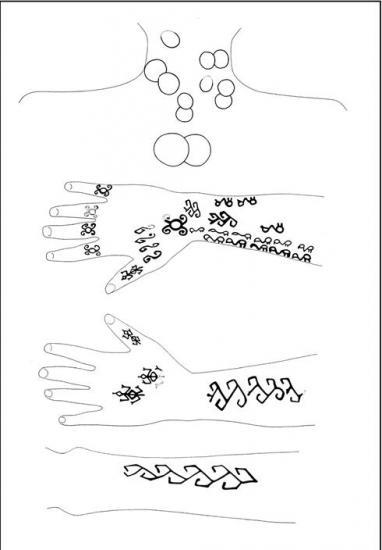Mummy tattoos hint at ancient Andean acupuncture
D. Vergano
Source : http://content.usatoday.com/communities/sciencefair/post/2010/10/mummy-tattoos-hint-at-ancient-andean-acupuncture/1

Tattoos found on the Chiribaya Alta mummy: Top: possible therapeutic tattoos on the mummy located on the neck and the upper part of the back. Tattoos have simple, circular, partly overlapping forms and would have been hidden by the neck hairs and the clothing during the lifetime of the bearer. Bottom: ornamental tattoos on the hands and leg of the same mummy depicting stylized apes, birds, reptiles and symbols.
Elsevier, JAS
Tattoos left on a 1,000-year-old Andean woman may cover acupuncture points, archeologists report.
In the current Journal of Archeological Science, a team led by Maria Anna Pabst of Austria's Medical University of Graz, "describe tattoos from two body areas of a mummy from Chiribaya Alta in Southern Peru." The team looked at the tattoos on the hands and neck of the mummy using various microscopic techniques.
"Tattoos displaying decorative elements are found widely on prehistoric mummies all over the world," notes the study:
The oldest known tattoos date from 6000 B.C. from the Chinchorros culture. They show a thin pencil mustache tattooed on the upper lip of a male adult. One of the most impressive sets of decorative tattoos was found on the skin of a Skythian nomad prince from the Altai mountain (500 B.C.). Aesthetically designed pictures of mythical creatures were tattooed on his arms, shoulders, chest, back and the right leg. But not only men were tattooed in ancient times: an obviously upper class female mummy was excavated in the Altay. She was enveloped in silk, crowned with a half-meter-high headdress and had a Skythian- pattern tattoo on her left arm. During exca- vations in a tomb of the Menthuhotep-temple in Deir el Bahari, figures, fish, birds, and what appeared to be landscapes, at about 1000 B.C.
The female mummy in the study is much more recent, from about 1,000 B.C., and bore tattooed animals like "birds, apes, reptiles in addition to symbols." Rings were tattooed on four of the fingers with soot.
Most intriguing to the researchers, 12 overlapping circles tattooed on the woman's neck resemble "therapeutic" tattoo spots corresponding to acupuncture points used to relieve neck pain. A 1999 study (not without disagreement) suggested similar therapeutic tattoos adorn the famous Tyrolean iceman mummy, Otzi.
Summarizing the possible medical intention lying behind the circle tattoos, we assume local problems of the upper spine or headaches as possible reasons for treatment by the tattooing. In contrast with the soot used in the decorative parts of the tattoos, partially pyrolyzed plant material, probably burned herbs, was used for the therapeutic neck tattoos.
Whether acupuncture pointers or not, the study shows that the pre-Inca population of Peru did differentiate between decorative tattoos and others.